The Complete Guide to Studying Matrikulasi in Malaysia
What degree can you study with a matrikulasi course? Browse study pathways, see entry requirements and what institution offer matrikulasi in Malaysia.

If you are looking to further your studies at local public institutions, there is a number of options available to you. Apart from Asasi (similar to Foundation courses at private colleges), public university diplomas and STPM, we also have the Malaysian Matriculation programme as well, widely known as Matrikulasi.
The Malaysian Matriculation is one of the preferred choices for students who are eyeing for coveted spots at public universities, as it is an extremely cost-effective route.
But is Matrikulasi the right choice for you?
In this comprehensive guide, we explore what the Malaysian Matriculation programme is all about so that you can make an informed decision about your future!
#1. The Basics of Matrikulasi
What It Is?
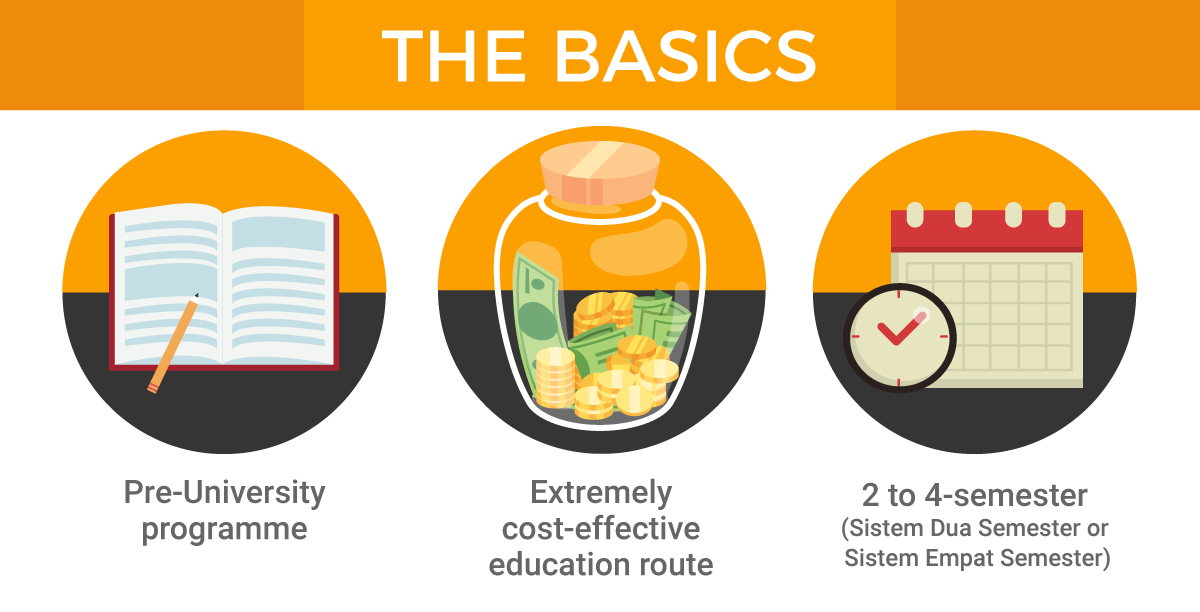
The Malaysian Matriculation Programme (in Malay, Program Matrikulasi Malaysia or more commonly known as just Matrikulasi) is a 2 or 4-semester pre-university course that allows you to pursue a degree upon successful completion.
Matrikulasi is one of the most sought-after pre-university programmes among Malaysians as it is an extremely cost-effective route into tertiary education. Students only need to pay a small registration fee, and the rest of the costs are borne by the Malaysian government. Matrikulasi students also receive an allowance every semester for their use.
Normally, students who opt for Matriculation will go on to pursue their degree with local public institutions. That said, the Malaysian Matriculation is also recognised by several foreign universities such as those from Australia, New Zealand and Japan.
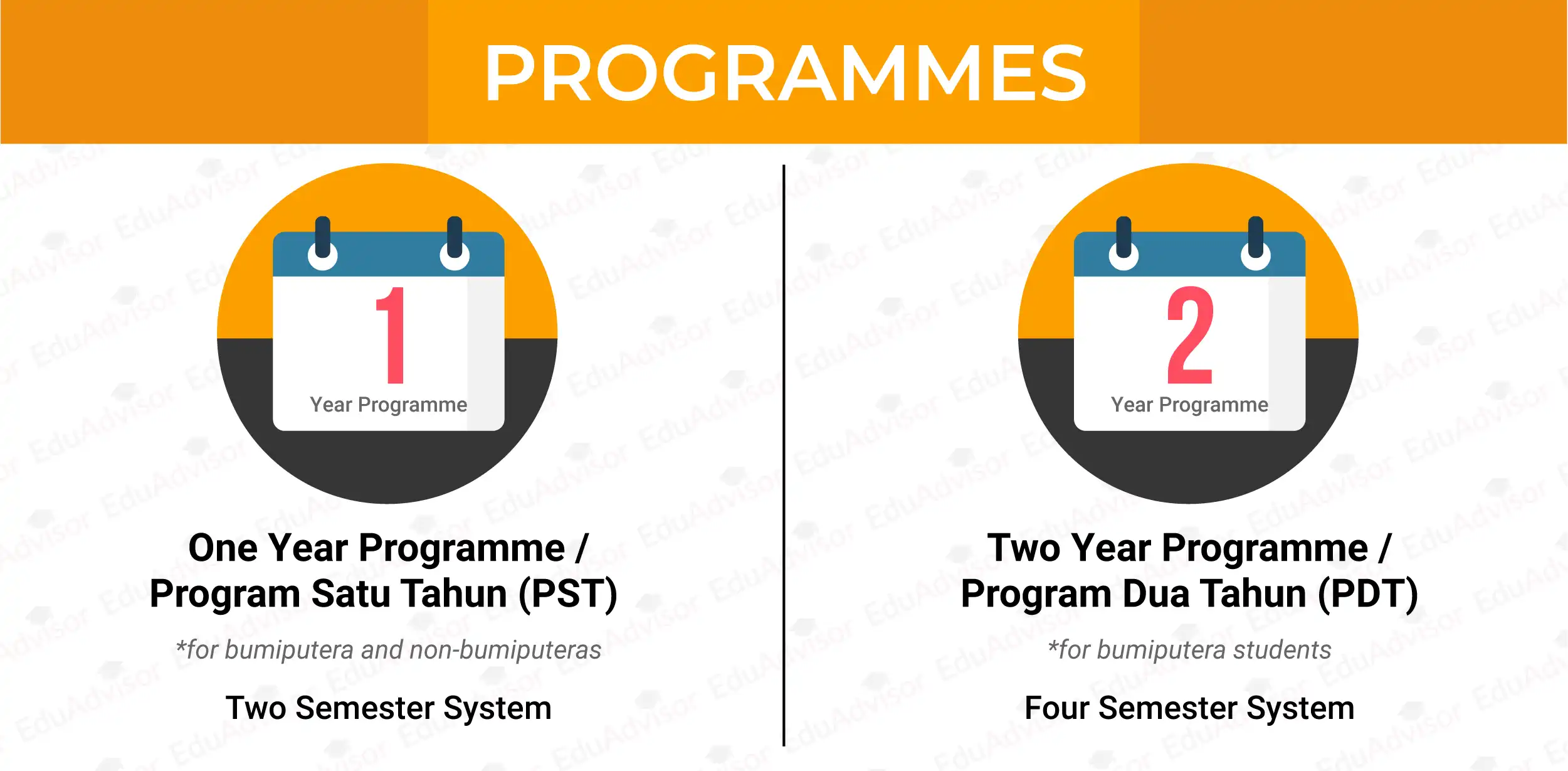
Matrikulasi has two programmes with different durations:
- One Year Programme (Progam Satu Tahun, in short, PST), or
- Two Year Programme (Program Dua Tahun, in short, PDT).
The Program Satu Tahun (PST) operates on a 2-semester system (sistem dua semester, or SDS), while the Program Dua Tahun (PDT) follows a 4-semester structure (sistem empat semester, or SES)
In other words, the local matriculation typically lasts up to 12 months (for SDS) or 24 months (for SES).
The Matriculation Division under the Ministry of Education has the prerogative to determine which students enter the SDS and which students enter the SES.
Matrikulasi is primarily reserved for bumiputera students, with approximately 10% of the spots going to non-bumiputeras. The two-year SES is only for bumiputera students, while the one-year SDS is for both bumiputeras and non-bumiputeras.
How Is Matrikulasi Structured?
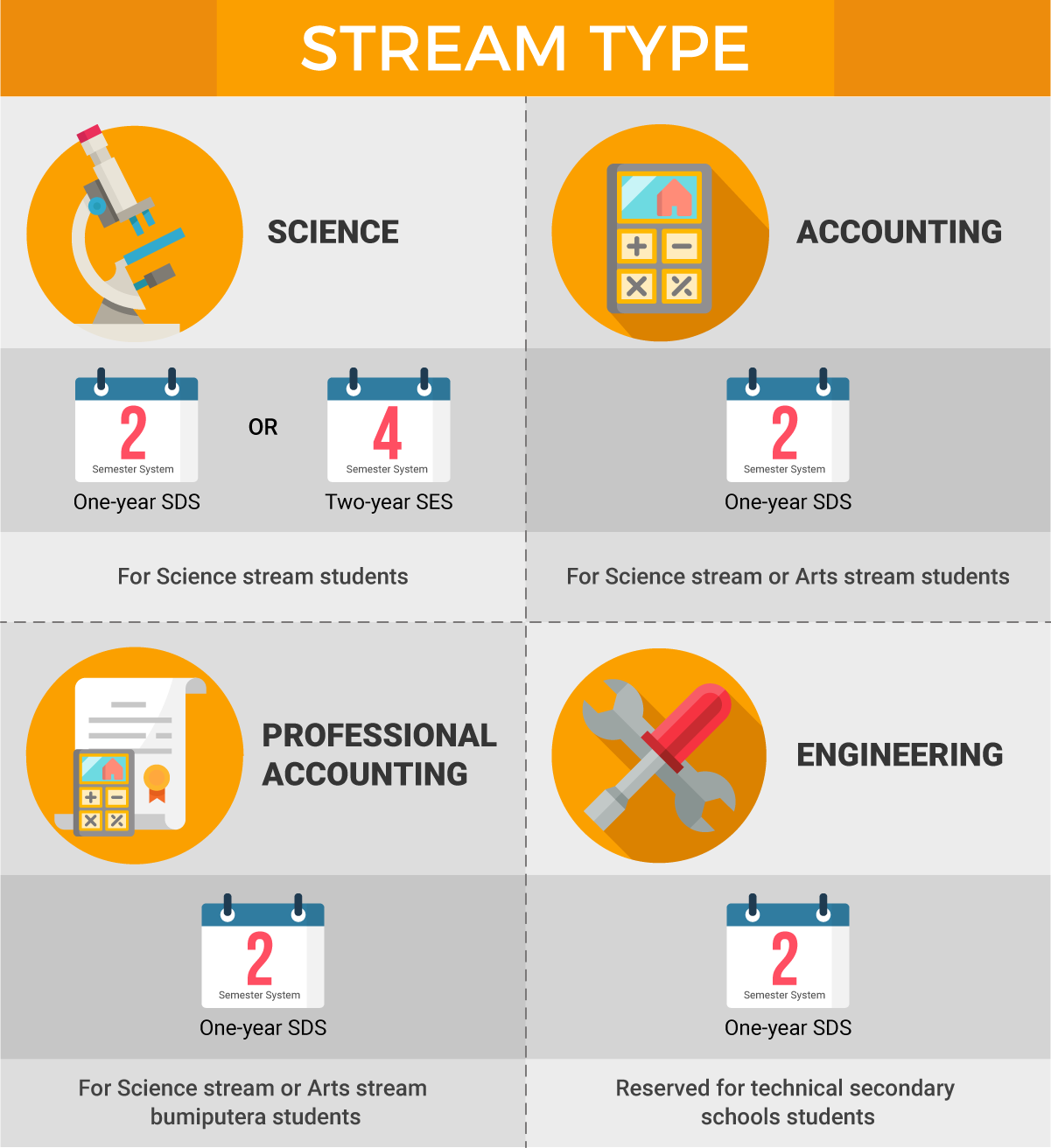
The Matrikulasi programme offers four streams, which are:
- Science stream (one-year SDS or two-year SES)
- Accounting stream (one-year SDS only)
- Professional Accounting stream (one-year SDS and for Bumiputeras only)
- Engineering stream (one-year SDS only)
If you are from the Science stream, you will be able to choose from all the four streams mentioned above. Students from the Arts stream can only opt for Accounting or Professional Accounting (if they are bumiputera). As for the Engineering stream, it is usually reserved for students from technical secondary schools.
There is no two-year programme for Accounting and Engineering streams. As such, bumiputera students who opt for Science stream will either be sorted into the one-year SDS or two-year SES, whereas non-bumiputera students will be sorted into the one-year SDS.

#2. How will you be evaluated?
Grading is similar to those of public universities, where Cumulative Grade Point Average (CGPA) is used to assess your performance. Your final CGPA grade is computed from all your Grade Point Averages (GPA) which you will obtain every semester. Your GPA is determined from the grade values associated with the grades that you obtain for each subject every semester (e.g. 4.00 for A, 3.67 for A- and so on).
In order to graduate, you will need to obtain a CGPA of at least 2.00. A CGPA that’s less than that will risk you having to repeat a semester or be terminated from the programme entirely. The maximum score that you can achieve is a CGPA of 4.00.
Upon completion of the programme, you can apply for public universities through Unit Pusat Universiti (UPU) online once you’ve obtained your Matrikulasi results.
If you are in the Professional Accountancy stream, you can further your studies in the Association of Chartered Certified Accountants (ACCA) at UiTM. However, if you do not meet the minimum requirements, you may apply to other eligible courses at UiTM or at any university that meet your qualifications.
#3. What Are The Subjects You Can Choose In Matrikulasi?
In general, Matrikulasi students do not have as much flexibility in subject choices compared to STPM. Science stream Matrikulasi students have 3 modules to choose from. Engineering stream students have 4 modules to pick. Meanwhile, the subjects for the Accounting and Professional Accounting streams are already fixed.
| Stream | Desired Tertiary Degree | Core Subjects |
|---|---|---|
|
Science Stream Life Science (Sains Hayat) |
Biophysics, Medicine, or other applied or life science courses | Chemistry Physics Biology Mathematics |
|
Science Stream Physical Science (Sains Fizikal) |
Information Technology, Engineering, or other applied science courses | Chemistry Physics Computer Science Mathematics |
|
Science Stream Computer Science (Sains Komputer) |
Information Technology, Medicine, or other medical or life science courses | Chemistry Computer Science Biology Mathematics |
| Accounting Stream | Accounting, Business, or other social science courses | Mathematics Accounting Business Administration Economics |
|
Engineering Stream Basic (Asas) |
Engineering, or other technical courses | Mathematics Chemistry Physics Basic Engineering |
|
Engineering Stream Civil (Awam) |
Engineering, or other technical courses | Mathematics Chemistry Physics Civil Engineering |
|
Engineering Stream Electric and Electronics (Elektrik & Elektronik) |
Engineering, or other technical courses | Mathematics Chemistry Physics Electric & Electronics Engineering |
|
Engineering Stream Mechanical (Mekanikal) |
Engineering, or other technical courses | Mathematics Chemistry Physics Mechanical Engineering |
| Professional Accounting Stream | Association of Chartered Certified Accountants (ACCA) | Business and Technology Management Accounting Financial Accounting Mathematics |
*In a sense, Chemistry and Mathematics are compulsory subjects for Science stream
There are also several compulsory subjects that you are required to take such as:
- English Language
- Pengajian Am Matrikulasi (General Studies)
- Islamic / Moral Education
In total, you will be taking 7 subjects.
You are also expected to participate and be active in co-curricular activities which are classified into:
- Sports / Games
- Clubs / Societies
- Uniform Units
#4. Why Should You Take Matrikulasi?
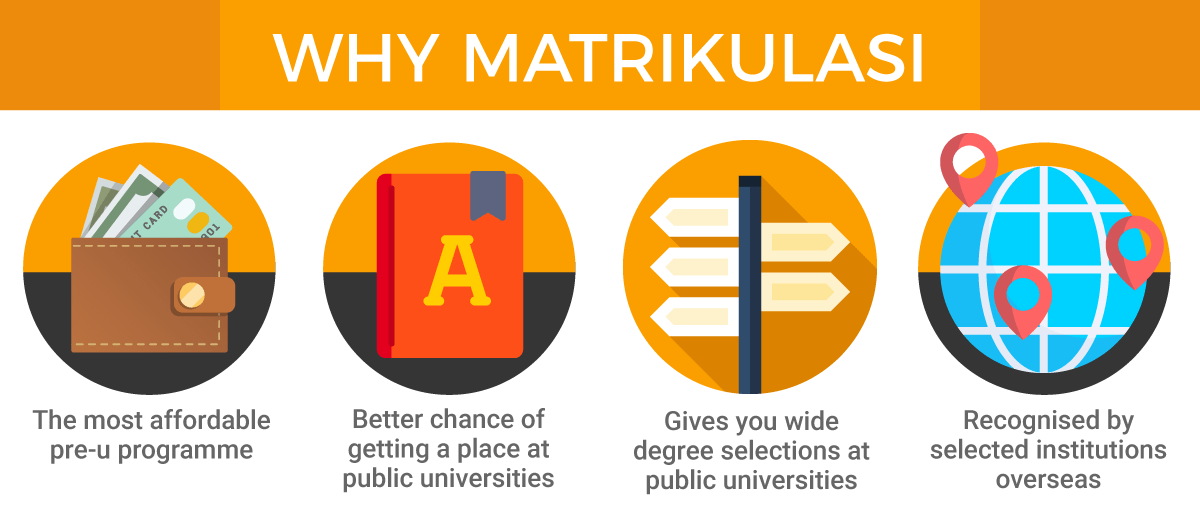
Compared with other national pre-university programmes available in Malaysia, the Malaysian Matriculation programme is hugely popular. Here are some reasons why it’s so popular and why you should consider this programme.
(1) Matrikulasi is extremely affordable
Matrikulasi is perhaps the most affordable pre-university programme in Malaysia. All you need to pay is the registration fee. The fees are as illustrated below:
| Streams | Two-Semester System (SDS) | MARA College | Four-Semester System (SES) |
|---|---|---|---|
| Science | RM599.60 | N/A |
RM599.60 |
|
RM284.60 |
|||
| Engineering | RM599.60 | N/A | N/A |
| Accounting | RM546.60 | N/A | N/A |
| Professional Accounting | RM546.60 + RM600 (books) = RM1,146.60 (Semester 1) |
N/A | N/A |
| RM546.60 + RM1,690 (ACCA fees) = RM2,236.60 (Semester 2) |
All the other costs are subsidised by the government and best of all, you will also receive a generous stipend every semester!
(2) Matrikulasi gives you a better edge in getting your desired degree at public universities
Apart from having a comprehensive list of public university degrees to choose upon completion, Matrikulasi students also tend to have a better edge in landing their desired courses compared to their STPM peers. Not only will you be graduating earlier from Matriculation compared to your friends in STPM, but you will also be handling toned-down syllabuses for your subjects compared to STPM. That said, you still need to put in the rightful effort in your studies (no reason to slack)!

(3) Matrikulasi gives you wide selections for your degree
Compared to other short pre-university courses like Asasi, Matrikulasi gives you a broader selection of courses that you can choose later on for your public university application. For example, if you are in Science stream, you can opt for a range of courses from Medicine to Engineering and even IT. For Accounting stream, you can apply for anything from Law and Economics to Human Resource Management!
(4) Matrikulasi is recognised by selected institutions overseas
Although the majority of Matrikulasi students pursue degrees in local public universities, there are selected universities abroad that recognise the local matriculation qualification. The Malaysian Matriculation programme is recognised and accepted by foreign countries like the United Kingdom, Australia and New Zealand.
#5. Who Is Matrikulasi For?
You should consider taking Matriculation if:
- You want a quick route to a public university degree
- You are very cost-conscious on your education
- You want to have a broad range of degree courses to pick
- You are self-initiated with your studies
- You are still generally unsure about which degree to pursue
- You want to aim for competitive public university degrees
You should NOT consider taking Matriculation if:
- You want to have an extensive choice for overseas degrees
- You are looking for a challenging environment to prep you for degree
- You want a richer pre-university experience
- You don’t like to don formal attire to class every day
#6. How To Apply To Study Matrikulasi In Malaysia?
Beginning from the 2020/2021 session, you will have to complete your application online through the UPU website to apply for a placement in Matrikulasi.
As with most pre-university courses, Matrikulasi is only applicable for SPM-leavers who have met their minimum requirements.
| Stream | Minimum Requirements |
|---|---|
| Science Stream |
Two-Semester System
|
|
Four-Semester System
|
|
| Accountancy Stream |
|
| Engineering Stream |
|
| Professional Accountancy Stream |
(You will also need to pass an aptitude test and attend an interview session) |
How Is the Selection Process?
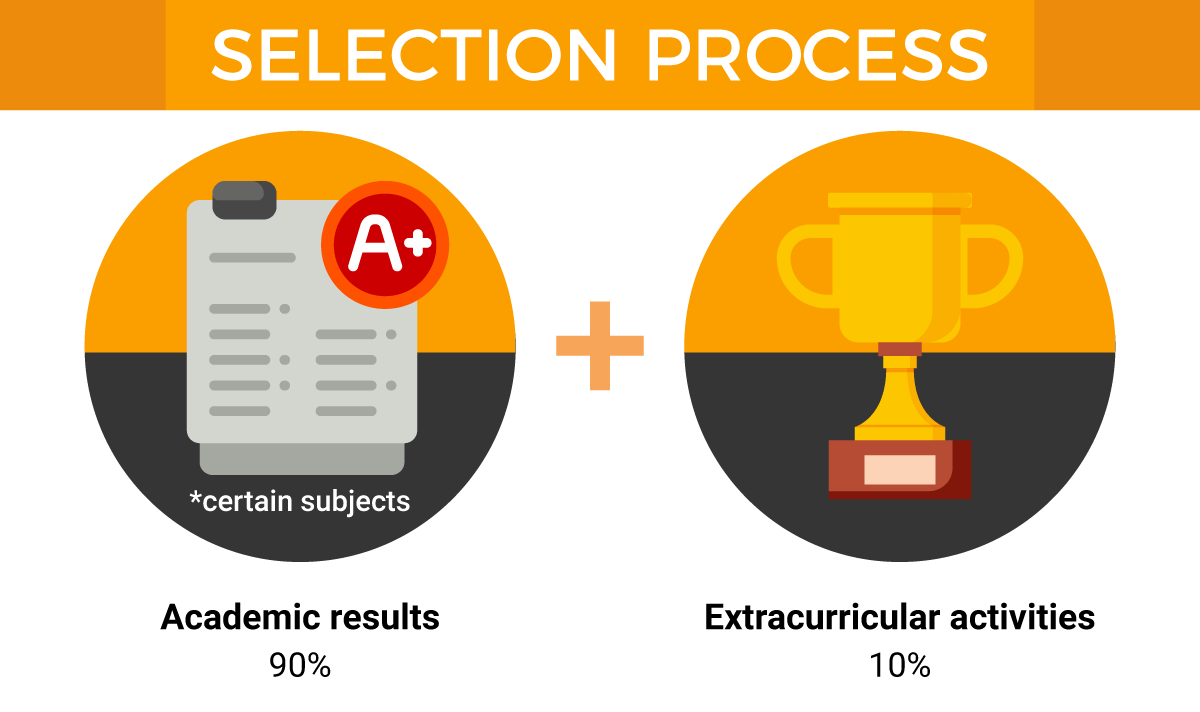
Students are selected via a meritocratic process, where your merits will be calculated by taking into account 90% of your academic results and 10% of your co-curricular performance. Your family will also be taken into consideration.
Note that the Professional Accountancy stream is only open for bumiputera students and you must pass the aptitude test and the interview. If your application does not meet the eligibility requirements of the aptitude test and/or interview, you will be consider for your second choice as long as you meet the entry requirements.
The results of your application to Matrikulasi is typically 21 working days from the release of SPM results.
You can also appeal online through UPU.
#7. Where Can You Go?
There are currently 17 matriculation colleges in Malaysia. The list of colleges/universities are as below:
| Matriculation Colleges Peninsular Malaysia |
Kolej Matrikulasi Perlis Kolej Matrikulasi Kedah Kolej Matrikulasi Pulau Pinang Kolej Matrikulasi Perak Kolej Matrikulasi Selangor (Professional Accounting stream) Kolej Matrikulasi Negeri Sembilan Kolej Matrikulasi Melaka Kolej Matrikulasi Johor Kolej Matrikulasi Kelantan Kolej Matrikulasi Pahang |
| Matriculation Colleges East Malaysia |
Kolej Matrikulasi Labuan Kolej Matrikulasi Sarawak |
| MARA Colleges | Kolej MARA Kuala Nerang (Accounting stream) Kolej MARA Kulim |
| Engineering Matriculation Colleges | Kolej Matrikulasi Kejuruteraan Kedah Kolej Matrikulasi Kejuruteraan Pahang Kolej Matrikulasi Kejuruteraan Johor |
PRO TIP
Matrikulasi students who wish to change their programme streams can make an appeal to the director of their respective colleges. The change in streams is subject to availability of the streams.


